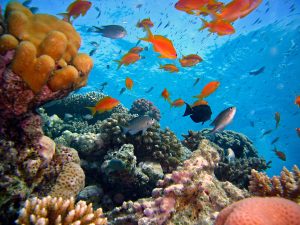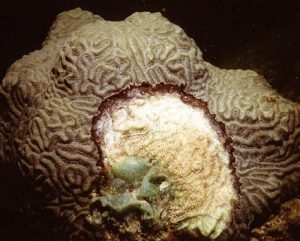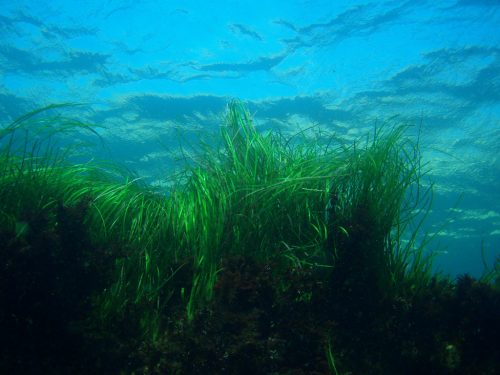Providing shelter to millions of exotic and colorful marine species, coral reefs are some of the most diverse ecosystems on the planet. From microscopic, photosynthetic algae to large, predatory sharks, a wide variety of organisms live within and among the coral polyps that compose these reefs. People flock from around the world to view these spectacular habitats, and local economies earn billions of dollars from tourism and fishing. Beyond its economic advantages, coral reefs also protect against the erosion of coastlines and serve as a source of chemicals currently used in medicine.
Coral reefs are valuable and beautiful, but they are also particularly fragile, currently endangered by climate change, pollution, ocean acidification, and disease. One of these threats, however, may have a natural solution. Research recently published in Science found that seagrass meadows reduce the abundance of pathogenic bacteria, mitigating disease in coral reefs and preventing the spread of waterborne human diseases.

In recent years, incidences of coral disease have increased around the world, from sites in the Caribbean to those in the Pacific and Indian Oceans, resulting in decreases in coral cover—the proportion of a reef’s surface that is covered by live coral. A variety of known microorganisms are associated with coral diseases, yet the pathogenesis behind several of these illnesses is complex and not fully understood. Multiple bacteria interact to cause some of these diseases, such as black band disease, a condition characterized by a band of bacteria that travels over coral and leaves behind a white skeleton. While current research struggles to understand the mechanisms behind coral diseases, the most recent study, led by Joleah Lamb of Cornell University, took a different approach and investigated how another ecosystem had been alleviating the problem all along.
Studying seagrass meadows, which grow in the sedimentary areas of land near shores, this team of researchers centered their research near four islands in the Indonesian Spermonde Archipelago. They chose sites with similar characteristics, monitoring the temperature, pH, and salinity of seawater from each site, and paired them so the only major difference in each pair was the presence or absence of a nearby meadow. At these sites, the researchers monitored bacterial levels in the seawater from four locations: the shore, the intertidal flats, the coral reefs, and the open water between islands.
The researchers first tested each location for Enterococci, a genus of bacteria often used to test for fecal contamination since it is found in human wastewater. Levels of Enterococcus were low in the open water, indicating that the bacterial source was wastewater pollution that had diffused from the islands. Closer to shore, Enterococcus levels were significantly affected by the presence of seagrass. Seawater samples collected at coral reefs with neighboring meadows had half the amount of Enterococcus as those taken from coral reefs without them. Furthermore, seawater collected at intertidal flats without seagrass had three times more Enterococcus than did the seawater sampled at seagrass meadows.
Since Enterococcus is found in human wastewater, its detection often indicates the presence of other pathogenic

bacteria. Knowing this, the researchers decided to analyze whether seagrass meadows affected the levels of other bacteria using a process called high-throughput amplicon sequencing. In this technique, segments of genetic material, called amplicons, are artificially amplified, purified, and sequenced. The procedure has several useful applications, since it can sequence a region of interest for multiple targets simultaneously. After sequencing, researchers can analyze the genetic variation within a sample after it has been sequenced or determine which organisms are present by comparing the sequences they obtained to a database.
Amplicon sequencing is commonly used for bacterial identification. When studying bacteria, researchers often use sequences from a particular gene,16S rRNA, because it is present in most bacteria and its size is appropriate for the technique. In this study, the researchers used this rRNA gene to analyze the composition of bacteria in their seawater samples. They took all sequences identified as bacterial, clustered similar sequences together, and compared their most abundant sequences to those within literature to classify the bacteria. They detected the presence of twenty-seven bacterial genera that are pathogenic to humans, marine fishes, and/or invertebrates. Of these, nine of the sequences were only found at the islands’ shores, so the team decided to analyze only the remaining eighteen. Again, they found that the relative abundance of pathogens was lower at sites with seagrass meadows than at locations without them.
With this information, the researchers decided to monitor how seagrass meadows affected the health of adjacent coral reefs by visually comparing the reefs in their paired sites. They looked for visual characteristics of diseased coral, including growth anomalies, eroding bands, and white syndromes—patches of dead, bone-colored coral skeletons. Based on their examinations, coral disease was twice as prevalent on reefs without an adjacent seagrass meadow. Two types of coral disease, white syndrome and black band disease, were particularly common within these reefs. The team’s results demonstrate that seagrass meadows help to alleviate disease in nearby coral reefs by reducing the concentration of pathogens within seawater.
Reducing bacterial load at these sites also keeps other organisms healthy. Several bacteria whose concentrations were reduced are also pathogenic for humans, fish, and other marine species. For example, the seawater samples included Vibrio, species of which can contaminate seafood and infect the humans that eat it, causing gastroenteritis—an inflammation of the gastrointestinal tract that results in diarrhea, vomiting and abdominal pain. Certain Vibrio species can also cause cellulitis, an infection of the skin resulting in hot, painful rashes.
With this publication, we now understand how important seagrass meadows are for the vitality of coral reefs. This study is the first to evaluate the ability of seagrass meadows to remove pathogens from seawater, but it is only one step towards understanding the complex and interacting ecosystems of the coast. Future research must determine the mechanisms involved. Lamb’s research team speculates that seagrass retains sediment and blocks sediment-associated bacteria from reaching nearby coral reefs, but this idea is still a hypothesis. Furthermore, discovering the pathogen-removing abilities of seagrass meadows does not solve the current problem of coral reef destruction.
Outbreaks of disease in reefs are only getting worse, as current trends towards higher global temperatures pose a threat to coral reefs in many ways. Increased temperatures may increase pathogen virulence, inhibit the ability of corals to fight against disease, and facilitate opportunistic infections. Seagrass meadows may currently protect some reefs against disease, but these ecosystems are also being lost at alarming rates. More than a quarter of the world’s seagrass ecosystems have disappeared in the last 135 years, and rates of destruction are increasing with coastal development.
Coastal ecosystems, from seagrass meadows to coral reefs, are fragile and easy to overlook, but they are economically and ecologically essential. They provide habitats for a diverse community of marine organisms and support the livelihoods of millions of people who depend on income from fishing and tourism. Research continues to unveil how organisms within these ecosystems interact. The question is, how do humans fit into the picture?

